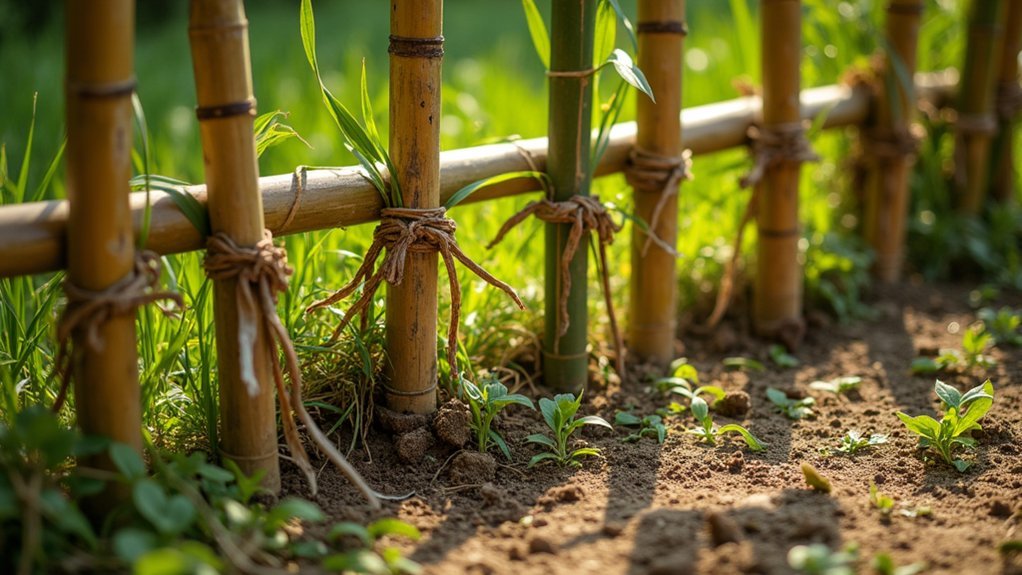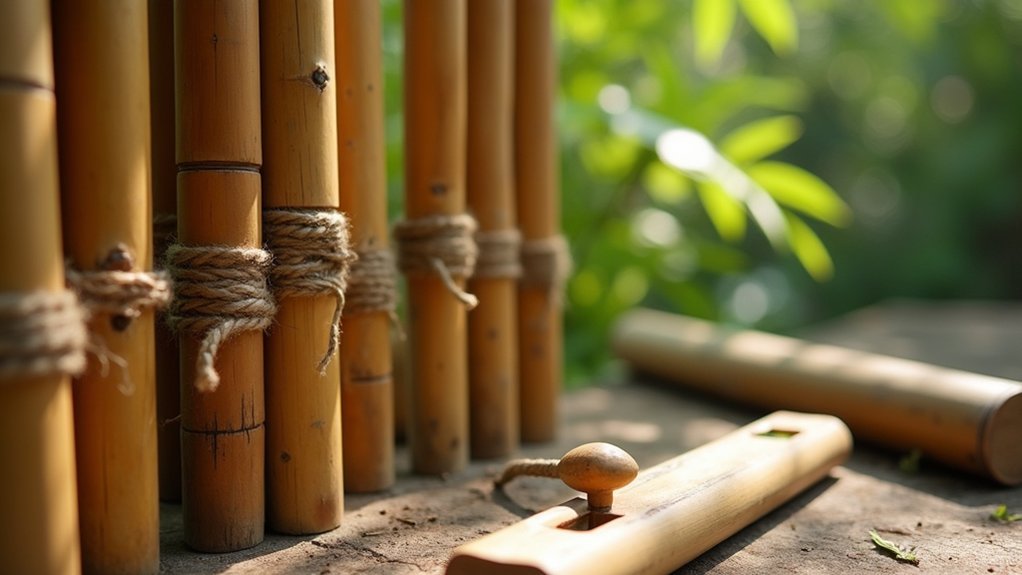Building a DIY bamboo fence starts with selecting quality bamboo like Dendrocalamus or Bambusa species. You’ll need basic tools including a spade, level, and protective gear. First, prepare your yard and mark the fence layout. Install treated wood posts in concrete, then attach bamboo panels using pre-drilled holes and screws rather than nails. Apply UV-resistant sealant to weatherproof your fence, and plan for annual maintenance. The following guide provides all details for your stunning natural barrier.
Selecting the Right Bamboo Material for Your Fence Project

Choosing the perfect bamboo for your fence project is the critical first step toward creating a beautiful, durable outdoor boundary. Focus on species like Dendrocalamus and Bambusa, known for their exceptional strength and longevity.
Consider diameter options carefully—¾ inch provides a lighter appearance while 1-inch poles offer greater structural integrity. For enhanced durability, look for carbonized bamboo, which undergoes heat treatment that darkens the color while improving weather resistance.
Pre-assembled panels secured with galvanized steel wire save significant installation time and guarantee longer-lasting connections that won’t rust. Be aware that minor cracking in bamboo poles is completely natural and will not affect the functionality or structural integrity of your fence.
When evaluating color options, remember that natural bamboo delivers a rustic aesthetic, while carbonized and caramel brown varieties provide richer, more sophisticated tones that complement modern landscapes.
These choices will directly impact both the appearance and lifespan of your fence.
Essential Tools and Equipment for Bamboo Fence Installation
Success with bamboo fence installation hinges on having the right tools at your disposal. Before starting your project, gather these essential categories of equipment to guarantee smooth, efficient progress.
- Basic installation tools: You’ll need a spade for digging post holes, a hammer for positioning, and a level to guarantee perfect alignment throughout your fence. For efficient work flow, set up two sawhorses to create a stable station for cutting and assembling panels.
- Safety equipment: Don’t overlook protection—working gloves prevent splinters, safety glasses shield your eyes, and a first aid kit should be nearby.
- Fastening materials: Three-inch wood screws work best for attaching pickets, while twine or wire can secure bamboo pieces in traditional designs.
- Measurement tools: A tape measure, straightedge, and pencil will help you achieve precise cuts and maintain consistent spacing between fence elements.
Preparing Your Yard and Setting Up the Frame Structure

With your tools gathered and organized, it’s time to focus on the groundwork phase of your bamboo fence project.
Begin by evaluating your yard, ensuring the ground is level and free of debris. Mark your fence layout clearly, indicating positions for support poles and panels.
Next, dig holes for your treated wood poles, making them deep enough to provide stability in all weather conditions. Space poles at appropriate intervals and set them firmly with concrete anchoring. Use a spirit level to verify everything is perfectly straight. Consider using 2×2 hardwood posts as they provide excellent support while maintaining a sleek appearance.
Proper pole placement provides the foundation for a lasting bamboo fence—dig deep, anchor firmly, and align perfectly.
While preparing the ground, remove any roots or large rocks that might interfere with installation.
Consider both aesthetic appeal and functional requirements like privacy or wind protection in your design. Apply protective finishes to your bamboo materials before installation to enhance durability against moisture and UV damage.
Assembling and Attaching Bamboo Panels to Your Framework
Four essential steps transform raw bamboo into beautiful fence panels. First, select straight, sturdy pieces with varying thicknesses, placing thicker pieces at the bottom for stability. Clean each piece thoroughly before measuring and cutting to fit your frame design.
When attaching bamboo to your framework:
- Pre-drill holes in the bamboo to prevent cracking
- Use screws rather than nails for a secure hold
- Guarantee bamboo pieces fit tightly with minimal gaps
- Consider using recessed holes in posts for horizontal pieces
For enhanced strength, incorporate multiple horizontal supports—typically three for standard height fences. For commercial properties, consider using metal frame kits that provide additional strength and protection against moisture damage.
You’ll achieve better structural integrity by arranging bamboo with tapering thickness. Don’t forget to explore pattern options and staining techniques to create a fence that’s both durable and visually striking.
Weatherproofing and Finishing Touches for Longevity

Your bamboo fence requires proper weatherproofing to extend its lifespan against the elements.
Apply multiple thin coats of UV-resistant, oil-based sealant after thorough cleaning and a 48-hour drying period.
Installing a decorative top rail not only adds aesthetic appeal but also provides additional protection against moisture penetration and structural stability. Regular inspection and maintenance will ensure your fence withstands high winds when properly secured with zip ties or screws.
Protective Sealants
The final barrier between your bamboo fence and nature’s elements comes from applying the right protective sealant. Choose from polyurethane, tung oil, natural waxes, or specialized bamboo products depending on your local climate and desired finish.
For ideal results, follow these application guidelines:
- Apply sealant when temperatures exceed 50°F with humidity below 70%, ensuring no rain for 48 hours.
- Clean bamboo thoroughly before application, working in vertical strokes to follow the grain.
- Apply 2-3 coats, waiting at least 3 days for the initial coat to dry and 1-2 days between subsequent layers.
- Perform annual inspections and reseal every 1-3 years, using the water bead test to check effectiveness.
Watch for poor adhesion on waxy surfaces and consider marine-grade products for extreme weather conditions. Lightly sanding the surface before applying sealant will help remove the natural waxy coating that can prevent proper adhesion.
Decorative Top Rail
Adding a decorative top rail to your bamboo fence serves as both the crowning touch for visual appeal and an essential shield against the elements. Choose cedar or pressure-treated wood for durability, ensuring it complements your bamboo aesthetically while providing structural support. The installation process is simplified when rails are primed and painted before being attached to posts.
| Rail Material | Benefits | Maintenance |
|---|---|---|
| Cedar | Naturally resistant, elegant look | Apply sealant annually |
| Pressure-treated | Cost-effective, long-lasting | Minimal upkeep required |
| Bamboo | Cohesive appearance | Replace every 3-5 years |
For maximum longevity, install metal caps on fence posts to prevent moisture damage. Consider applying water-repellent coatings that maintain breathability. Remember to seal all gaps between materials to block moisture infiltration. For a truly unique look, incorporate decorative trims or integrate solar lighting along the top rail for evening ambiance.
Seasonal Maintenance Tips for Beautiful Bamboo Barriers
To guarantee your bamboo fence remains beautiful year-round, you’ll need to adjust your maintenance routine with each season’s unique challenges.
Prepare for weather changes by inspecting posts and hardware, applying appropriate sealants, and addressing drainage issues before they cause damage.
Natural preservation methods like proper cleaning, adequate ground clearance, and regular inspections will extend your fence’s lifespan while maintaining its aesthetic appeal. Check metal parts for signs of rust or corrosion and clean them promptly to prevent damage to connecting points.
Preparing for Weather Changes
Although bamboo is naturally robust, your fence will require regular care to withstand the elements throughout changing seasons. Implementing preventative measures before harsh weather arrives will extend your fence’s lifespan and maintain its aesthetic appeal.
1. Foundation Protection – Guarantee your fence has at least 100mm ground clearance and proper drainage to prevent moisture damage.
Pack dirt or pour cement around posts for enhanced stability.
2. Regular Inspections – Conduct yearly checks of fasteners, posts, and bamboo sections.
Replace damaged pieces promptly to maintain structural integrity. Bamboo fencing is particularly termite resistant compared to traditional wood options, but still requires checking for other types of insect damage.
3. Surface Treatments – Apply bamboo sealant annually before summer.
Re-stain every 2-3 years to preserve color and protect against elements.
4. Debris Management – Remove accumulated debris with low-pressure washing annually and keep vegetation trimmed away from the fence surface.
Natural Preservation Methods
Natural preservation techniques enhance your bamboo fence’s longevity while maintaining its environmental benefits. Harvest during the dry season to minimize moisture content and reduce rot risk. After installation, establish a regular maintenance routine including cleaning with mild detergent solutions and thorough drying. For optimal preservation, consider a combination of beeswax and linseed oil applied to bamboo surfaces to create a natural protective barrier.
| Maintenance Task | Frequency | Benefits |
|---|---|---|
| Apply borax/boric acid | After installation | Deters insects, replaces sugars with salts |
| Seal and stain | Every 2-3 years | Maintains appearance and structural integrity |
| UV protective coat | Annually | Prevents sun damage and weakening |
For best results, soak your bamboo in preservative solutions for several days before installation. During treatment, guarantee adequate ventilation to avoid fume inhalation. Remember to wear protective gear when applying chemicals and adjust preservative concentration based on your bamboo species and local environmental conditions.
Frequently Asked Questions
How Do Bamboo Fences Affect Surrounding Plant Growth?
Your bamboo fence can impact surrounding plants by competing for water and nutrients, creating shade that limits sunlight, providing wind protection, and adding organic matter to soil when leaves fall and decompose.
Can Bamboo Fencing Be Installed on Uneven Terrain?
Yes, you can install bamboo fencing on uneven terrain using stepped or racked designs. You’ll need to adjust post heights and possibly use contouring methods to follow the land’s natural shape for a secure installation.
Are Bamboo Fences Safe for Homes With Small Children?
Yes, bamboo fences are safe for homes with small children. They’re strong, splinter-resistant, and don’t have sharp edges. You’ll want to guarantee proper installation with close panel spacing to prevent climbing or squeezing through.
How Do Bamboo Fences Compare to Other Materials for Noise Reduction?
Bamboo fences are less effective at noise reduction than solid barriers like concrete walls, but they’ll still mask some noise naturally. You’ll get better results with denser, taller bamboo plantings and additional sound-absorbing features.
Do Bamboo Fences Require Special Permits in Residential Areas?
Generally, you don’t need special permits for bamboo fences in residential areas, but check your local zoning laws and HOA rules. Height restrictions (typically 6 feet) apply, and some areas have specific bamboo containment regulations.
In Summary
With your new bamboo fence installed, you’ve created a natural, sustainable barrier that adds character to your outdoor space. Remember to apply a protective sealant annually and inspect for damage after severe weather. By following the maintenance tips outlined, you’ll guarantee your DIY bamboo fence remains beautiful and functional for many years to come. Enjoy the privacy and aesthetic appeal of your handcrafted creation!





Leave a Reply